The Sale of the Glossop Dale Estate.
It is well known that the Glossop Dale Estate was sold off following the death of Francis Edward, the 2nd Baron Howard of Glossop, on 22 September 1924. What is less well known is that he had tried to sell off part of the Estate almost four years earlier.

Various properties in Ludworth, Chisworth and Marple Bridge were offered for sale by auction on 2 December 1920.
In the event the sale was largely unsuccessful, the only properties sold being: Farm buildings and accommodation land off Compstall Road and the buildings thereon (£395); Buildings and land off Eastside, Compstall Road, Ludworth (£375); The Gun Farm, Ludworth and Mellor (£570); Hollins Lane Farm, Mill Brow, Ludworth (£600); The farm fronting Sandy Lane and Sanders Lane, Chisworth (£2,400); The farm No. 11 Sandy Lane, and cottage, and No. 9 Sandy Lane, Chisworth (£650); The cottage 12 Chisworth Fold (£48).
The following properties were withdrawn because there were either no offers or the bids were not high enough: Ernscroft Hall at Ludworth; Lower Fold Farm, Ludworth; Cote Green Farm; Hollins Farm, fronting Hollins Lane, Ludworth; Hillside Farm and Ash Tree Farm, Cote Green Lane, Ludworth; Lane Ends Farm, fronting Glossop Road and Lee Lane, Ludworth; Cowhey and Twitches Farm, off the Glossop Road; Stirrup Farm, Ludworth; Woodheys Farm, Ludworth; land and buildings at Stirrup Benches,Ludworth; Ernocroft Farm, Stirrup Benches, Ludworth; Ernecroft Farm, Stirrup Benches; Greengate Farm, Dirty Lane, Ludworth; Clough End, Ludworth;s Far Bradshaw Farm, Ludworth and Mellor; Smithy Lane Farm, Ludworth; Brookbottom Farm, Smithy Lane, Ludworth; a farm in Hollins Lane, Mill Brow, Ludworth; land fronting Glossop Road, Holehouse and Sanders Lane, Chisworth; Far Woodseats Farm, off the Glossop Road, Chisworth; Boarfield Farm, off Glossop Road, Chisworth; the farm at Sander Lane, Chisworth; Intakes Farm, Chisworth; Hill Top farm, Chisworth; land at New Mills Road, Chisworth; land at Hodgefold, Chisworth; land, etc. fronting to and near South Side Glossop Road; Moorside Farm, Chisworth; Far Coombes Farm, Chisworth and Charlesworth; land used as a recreation ground at South Side Glossop Road, Chisworth; the Hollins Lane Allotments, Ludworth.
The Pall Mall Gazette of 3 December 1920 reported:
Lord Howard of Glossop’s extensive estates at Chisworth, Ludworth, consisting of 2,400 acres of farms and moors, were under the hammer last night, but only 195 acres were sold, realising £5,038. There were no offers for many farms. A cottage sold for only £48.
The Sheffield Daily Telegraph of the same date added: No offers were made for most of the farms.
As mentioned, the 2nd Baron Howard of Glossop died on 22 September 1924 and it was not long before the first moves to dispose of the Estate occurred.
The Derby Daily Telegraph of 5 December 1924 reported:
A sensation has been created in Glossop by the decision of Lord Howard of Glossop, who recently succeeded to the title on the death of his father, the second baron, to dispose of the Glossop estate which is a very extensive one, comprising valuable urban land, with large works and factories thereon, and many acres of well-wooded land with magnificent water supplies, as well as fine shooting moors.
Most of the land is situated in the prettiest part of the Peakland country, and Glossop Hall itself, which is included in the sale, is one of the most charming spots in Derbyshire. It is a fine old manoral fabric. Turreted and towered, it commands a wide prospect, with wooded dells, fine boating lake, charming gardens, and pleasant coverts, with views from its windows of many Peakland ranges, including the famous Doctor’s Gate Path, which was the old bridle road to Sheffield, and the equally famous heights known as the Nab and Peak Naze.
In a letter to his tenants Lord Howard says his decision to sell is caused by the heavy death duties he has to pay. He regrets the necessity for severing his connection with the tenants, many of whom have been on the estate for a long period, but in order to cause as little disturbance as possible he has instructed the agents acting on his behalf to give as far as practicable every tenant the opportunity of purchasing his holding, assuming such tenant is prepared to pay the price Lord Howard may be advised is reasonable.
On the part of the tenants it is necessary for them to enter into definite contracts before Feb. 28th. as after that date no offer will be entertained under any circumstances and every holding not then sold will be offered by auction.
In a briefer article under the headline "Town To Be Sold”, the Liverpool Echo mentioned: The property comprises practically all the land in and around the town, 150 farms and small-holdings, woodlands, quarries and 1,800 ground rents.
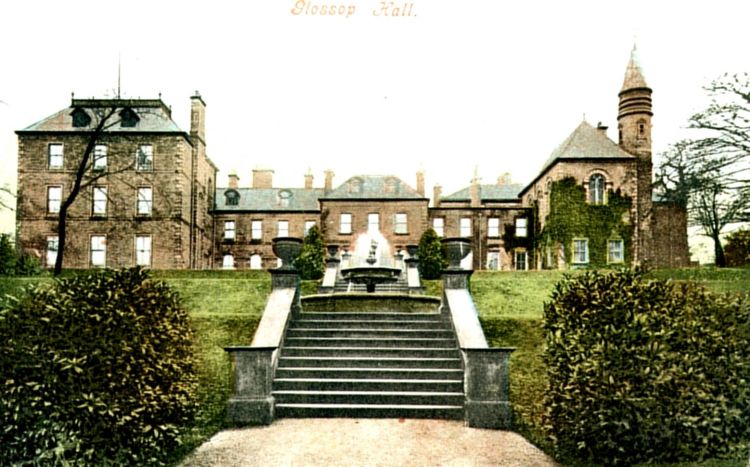
An advertisement in the Sheffield Daily Telegraph of 19 December 1924 announced that Glossop Hall would be included in the sale of the Glossop Dale Estate. It was described as a Comfortable Well-Built Stone Mansion Finely placed 600 feet above sea level in a timbered and walled miniature park, with Lodge entrance, containing 16 principal Bed and Dressing Rooms, 5 Bathrooms; ample Staff Accommodation; Private Chapel; Complete Domestic Offices; Capital Stabling and Garages; Coachman’s Cottage; Electric Light; Heated; Main Water. Old World Gardens, with terraces, walled Rose and Fountain Gardens, Ornamental Water, Tennis Courts, Kitchen Gardens with Cottage. Valuable frontages to main roads. The whole extending to about 50 Acres. To be Sold with Possession at once, or with about 10 acres.
When it was announced that the estate was to be sold, Glossop Council considered buying it in its entirety, to run as a going concern in order to provide income for the town. A report in the Glossop Advertiser in 1925 explained that the Council was prevented from doing so by the fact that it (in common with other municipal corporations) had no power to hold land except for some purpose authorised by the statute which governed it. There was no time available to try to obtain the necessary powers from Parliament so the idea had to be shelved.
Lord Howard then sold the estate to a private individual who decided to divide the estate into several lots and sell it by auction. The Sheffield Daily Telegraph of 6 February 1925 reported:
The Glossop Dale Estate, the property of Lord Howard of Glossop, extending to 11,000 acres including Glossop Hall, 150 farms, and small holdings, numerous cottages, water rights, and quarries, the grouse moors, and the ground rents secured upon the greater part of the town of Glossop, and the adjoining villages, has been sold by Messrs. Knight, Frank and Rutley in conjunction with Messrs. William Davies and Sons, of Manchester, to a client of Messrs. Collins and Collins, of South Audley Street. The estate was for sale in consequence of the death of the late Lord Howard of Glossop in September last. The purchaser will carry out the arrangements which have already been made by the vendor in respect to sales to tenants.
The Yorkshire Post and Leeds Intelligencer of 30 May 1925 published a report under the headline Future of Glossop Dale Estate. It read:
What was Lord Howard's Glossop Dale estate in North Derbyshire, extending to 11,000 acres, is to be going under the hammer in September, and, like so many others, will be sold piecemeal. This estate, which has an especial interest for people situated in the triangle formed by Sheffield. Manchester. and Stoke, was, after the death of the late Lord Howard of Glossop, bought by Messrs. Stamford and Head, solicitors, Bradford, acting on behalf of Mr. John Todd, of Northallerton. It is this gentleman's intention to sell the estate by auction at Glossop in the autumn.
Although the mansion on the estate (Glossop Hall) has no great historical associations, being of comparatively modern construction, and will not, by reason of its situation in the town of Glossop, offer much inducement to a purchaser as a residence, it makes a special appeal to the Glossop local authorities by reason of its suitability for an Art Gallery or Museum, a Grammar School, or a Poor Law institution. It is splendidly situated in a large park and this portion of the estate and that containing the Glossop Corporation Waterworks are being discussed by the municipality with a view to purchase.
Glossop Dale, too, will make a peculiar appeal to the small holder, for it includes over 150 farms - a large number of them being but 20, 30 or 40 Acres in extent - suitable for men who desire to market their produce direct to the large population which fringes the estate. Some of the holdings are so small and compact that they will probably sell at less than £1,000, whilst others - ranging up to 200 acres - will suit the purpose of farmers who desire to trade on a larger scale.
In addition to over 5,000 acres of grouse moors, there are for disposal ground rents producing nearly £11,000 per annum, including many with valuable early reversions. Builders, too, have a splendid opportunity to acquire sites for housing development on economical lines, for there is abundant stone to be obtained from the quarries on the estate. Certain portions of the estate have already been sold privately, but most of the properties will come into the market in the autumn. Full printed particulars will, it is expected, be available in July. Messrs. Stamford and Read, of Bradford, are the solicitors acting in the matter.
The same newspaper, in its issue of 28 August 1925, reported on the fact that several large estates were about to come on the market:
Several big estates in the North are coming under the hammer shortly, and the autumn season promises to be a busy one. In point of size and importance the coming sale of the Glossopdale estate, in North Derbyshire, takes leading place. When this famous and extensive property came first into the market after the death of Lord Howard of Glossop, it ran to about 11,000 acres; and it was acquired by Messrs. Stamford and Read, solicitors, Bradford, on behalf of Mr. John Todd, of Northallerton.
Since then he has carried out the arrangements made with the present peer that the tenants should have the opportunity of purchasing their holding with the result that numerous lots have been sold privately, and the total acreage to be disposed of by auction has been reduced to 7,400 acres. Even so no fewer than 300 lots will await bids at Glossop on September 16 and 17. They are mostly in and around the town of Glossop and the surrounding villages of Dinting, Hadfield, Padfield, Charlesworth, Simmondley, Marple Bridge, Chisworth, and Chunal - all on the fringe of the Peak district. The Glossop Corporation have been considering the advisability of purchasing the mansion on the estate, Glossop Hall (a stone built house in the French château style), with a view to its utilisation for some public purpose, together with that portion of the estate which includes the municipal waterworks, but so far no agreement has been come to. In addition to the mansion the properties to be offered by Messrs. Knight. Frank, and Rutley include 125 dairy, stock, and small holdings, and the grouse moors of Shelf and Coldharbour and Hurst and Chunal. A considerable portion of the estate is ripe for immediate development, there being miles of frontages to existing roads. All the yearly tenants of the farms and small holdings have been served with notices to quit, expiring on Lady Day of next year.
The Glossop Corporation bought some parts of the estate of which it was the tenant: The land between Norfolk Street, Fauvel Road and Lord Street, used as a the Grammar School playing fields; The land between Surrey Street and the railway line which was the site of the Town's Yard; The field south of Surrey Street, adjacent to the Glossop Iron Foundry, which was part used as a refuse tip and on which Glossop F.C.'s ground would later be built; The site of Hadfield Town's Yard adjacent to Old Hall Square; The site of the Recreation Ground adjacent to the Brookfield Congregational Chapel; The fields on Newshaw Lane to the south west of St. Andrew's Cricket Field; The refuse tip on Woolley Bridge Road adjacent to the Waterside Branch railway; The refuse tip at Dinting behind the Viaduct Inn; The site of the Infectious Diseases Hospital at Gamesley and A plot of grassland off Silk Street, north of Hurst Brook.
Mossy Lea Reservoir, also tenanted by the council, was withdrawn from the sale.
The Corporation was also offered Glossop Hall and grounds but, on 4 June 1925, members rejected the offer as, at that time, they could see no purpose which would meet the statutory requirement which bound them. The owners contacted Derbyshire County Council, which inspected the Hall with a view to using it for a grammar school, but the offer was rejected.
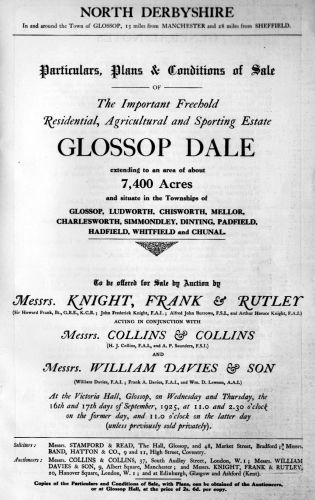
On 16 and 17 September 1925, the Freehold Residential, Agricultural and Sporting Estate of Glossop Dale was put up for auction as 305 lots. The estate extended to an area of about 7,400 Acres and comprised land and properties in the Townships of Glossop, Ludworth, Chisworth, Mellor, Charlesworth, Simmondley, Dinting, Padfield, Hadfield, Whitfield and Chunal.
The properties included: about 125 Dairy, Stock and Small Holdings; Glossop Hall, described as a substantially constructed and comfortable Mansion, with grounds and Gardens of exceedingly charming character; Spire Hollin House, and Estate Offices; “Easton”; several Dwelling houses; Building Land; Numerous Cottages and Gardens; The Noted Grouse Moors of Shelf & Coldharbour and Hurst & Chunal; Profitable Stone Quarries and a Sand Pit.
The summary of the accommodation of Glossop Hall was: Oak-panelled Hall; 5 Reception Rooms; Boudoir; 14 Principal and Guests’ Bedrooms; 2 Dressing Rooms; Central Heating; Private and Corporation Water Supplies; 12 Servants’ Bedrooms; 3 Nurseries and School Room; 8 Maids’ Bedrooms; 5 Bathrooms and 7 W.C.’s.; Company’s Electric Light; Main Drainage; Fire Hydrants; Stabling, providing accommodation for 14 horses, with Men’s Living Accommodation; Three Coach Houses or Garages, and two Lodge Entrances; Grounds, including Italian Garden, Terraced Lawns, Chain of Fishponds, beautiful Hanging Woods and Parklands.
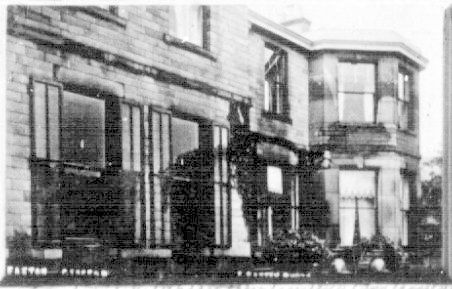
Easton
The Sheffield Daily Telegraph of 19 September 1925 reported that many lots failed to find a purchaser:
Many notable lots were on offer at the sale of the Glossop-dale estate, comprising 7.400 acres, but a good number of lots were withdrawn, reserve prices not being reached.
The modern buildings and land - over 65 acres - known as Lord Howard's Home Farm, elicited a first bid of £1,500, but was withdrawn at £2,600. Spire Hollow (sic) House, together with the Howard estate office, in nearly three acres of land, started at £1,500, and was sold at £2,050 to the Glossopdale Cooperative Society, which had previously purchased a large plot of land in the vicinity. The mansion known as Glossop Hall was put on the market. It has for generations been the seat of the Lord Howards of Glossop and is set in 11 acres of gardens and woodland scenery. Bidding commenced at £5,000 and at £8,500 it was withdrawn, Bidding for the park land and grounds of Glossop Hall went up to £7,000, at which they were withdrawn. Easton House went to Mr. T. W. Ellison for £1,200; Mossy Lea House went for £455; Shire Hall (sic) Wood of 103 acres went to Mr. E. Greenwood for £925; Shaw Farm was sold for £925 to Mr. R. Wilson.
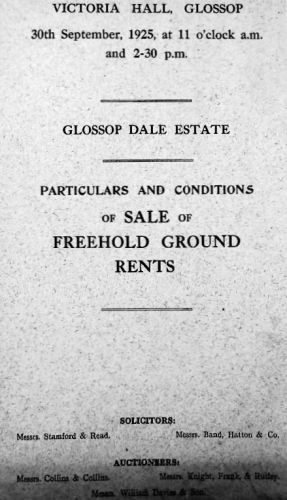
A fortnight later (30 September 1925) an auction was held of the Freehold Ground Rents payable out of Licensed Premises, Clubs and Dwelling-houses, situate in the Townships of Glossop, Ludworth, Charlesworth, Chisworth, Simmondley, Dinting, Padfield, Hadfield, Whitfield and Chunal. There was a total of 155 lots.
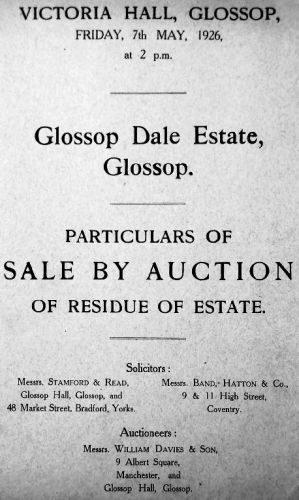
The greater portion of the unsold lots from the September 1925 auctions were offered for sale by auction on 7 May 1926. The sale comprised 294 lots. Not all were sold and were then advertised for private sale. For example, the Sheffield Daily Telegraph of 9 and 10 June 1926 carried advertisements reading:
On Sale. - Farms forming part of remainder of the Glossop Estate, acreage from 18½ to 186 acres; vacant possession ; to be Sold very cheaply to immediate purchasers. - Robert Wilson, Ltd., Glossop
Footnote:
John Overend Todd was a property dealer who lived at Mill Hill, Brompton, Northallerton. He died on October 27 1939, aged 76 years, and left £142,256, with net personal property of £24,044. Estate duty was estimated at £5,772.
Return to GJH.me Home Page, Return to Glossop Area Local Histories index.
Last updated: 22 October 2022






